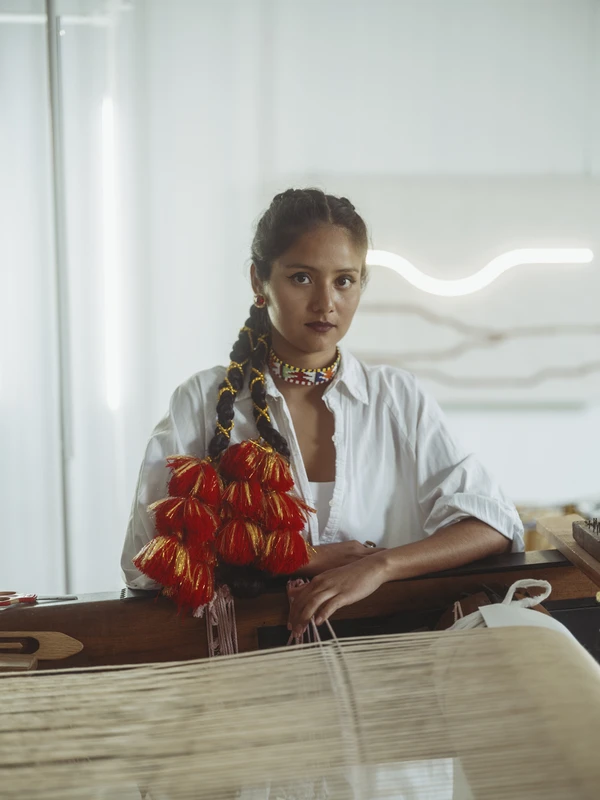Kenia Almaraz Murillo: Andean Cosmovision
16 Nov 2024-6 Feb 2025
PV 14 Nov 2024, 6-8pm


Waddington Custot is delighted to present the gallery’s first show of Kenia Almaraz Murillo (b. 1994, Santa Cruz de la Sierra, Bolivia) after announcing global representation of the artist earlier this year. Rich in cultural reference and personal history, Kenia’s distinctive work explores familial legacies, Andean mythologies, and diasporic identity. Taught weaving in Paris by the nonagenarian textile artist Simone Prouvé, Kenia uses her practice to connect with the generations of weavers among the women in her family in Bolivia, and her large wall-based sculptures, hand-woven from her Paris studio, blend Andean tradition and references to modern Bolivian life with a unique diasporic perspective.
Kenia’s ambitious wall hangings are created with indigenous South American yarns, the surfaces of which are adorned with found urban objects, such as car reflectors and motorbike headlamps or items sourced from traditional Bolivian markets, lit with neon LED lights. In her new series, the artist introduces embroidered motifs from carnival costumes designed for the iconic Carnival of Oruro, in which pre-Columbian Andean deities and the Catholic Virgin del Socavón are venerated alongside one another in lively performances describing Bolivia’s resilience after histories of colonialism and slavery. Kenia Almaraz Murillo: Andean Cosmovision will debut 15 unseen wall-based works, including 10 larger woven pieces, and five smaller sculptures incorporating a wooden infrastructure and painted threaded wool, which inhabit the final space of the gallery.
After moving to Paris from Santa Cruz de la Sierra at the age of 11, separated from her parents, Kenia progressed through the French education system, eventually learning the language and embracing her new environment. Returning to Bolivia to visit only years later as a teenager, an experience which overwhelmed her with sensory memories of her childhood, Kenia was transfixed by her mother’s aguayos, patterned woven cloths, which were cared for as family treasures. Kenia would discover her grandmother and great-grandmother were skilled weavers, and the aguayos took on new significance as physical memories of her ancestors, bearing the trace of their working hands; as their new guardian, Kenia would bring them with her on her return to France.
The body of work presented by Kenia at Waddington Custot will be some of her most personal to date, developed after more recent trips to Bolivia. Kenia spoke to locals, family members and neighbours about the legends passed down through generations, eventually responding to these stories and traditions with a new set of wall-based sculptures. One such example is ‘Ekeko’, 2024, in which white neon LED strips illuminate a shelf holding trinkets and offerings including rolls of banknotes, the shoes of the Virgin, and little bags of sugar, grains, rice and candies made solid with resin. Every year on 24 January at midday, similar objects are taken to local shamans across the Andean area of Bolivia to be blessed; Kenia’s work alludes to this traditional ceremony.
On the main parade day of the Carnival of Oruro, exuberantly dressed performers can dance for up to twenty hours without stopping, in complex, choreographed parades. ‘Los Urus’, 2024, incorporates original components of some of the dancers’ elaborately embroidered costumes, which include symbols of the Uru mythology such as lizards, ants, toads, snakes and condors. These colourful beings of pre-Columbian folk tales feature regularly in Kenia’s series, liberated from any linear narrative. ‘El Katari que se extravió’, 2024, conjures the community legend of the amaru or katari, a mythical mountain snake which, by lying across the horizon line, created the distinctive shape of the mountains near to the community of which Kenia’s family is a part. In ‘El Condor’, 2024, neon LED lights in clear plexiglass describe the abstracted wings of the sacred Andean bird in flight; ‘El Lagarto’, 2024, employs the same illuminated bars to suggest the vertebrae of the lizard in the work’s title, while in ‘La Hormiga’, 2024, they describe the head and front legs of an ant, with motorbike lights forming its abdomen and thorax.
These creatures reappear in the final room of the exhibition, titled by Kenia as Le Temple du Sommeil or ‘The Temple of Sleep’, where she imagines each of the beasts in slumber. Sleep is tantamount to a spiritual experience for Kenia who often draws inspiration from her dreams. She describes sleeping as being ‘dead physically’, with the possibility each time of not returning to the waking world, and she became curious about the ways in which other creatures and beings might sleep. Created with strands of wool and paint on an illuminated, wooden armature, each of these threaded sculptures casts its own gentle light, creating a different atmosphere to the rest of the exhibition.
Kenia is part of the traditional Bolivian dance ensemble Caporales Mi Viejo San Simon, based in Paris, which performs across Europe. Their powerful routines reenact the relationships between colonisers and slaves, in a story of transcendence through suffering, expressed with synchronised dance. At the opening of the exhibition, Kenia will introduce a dance performance by London-based members of Caporales.